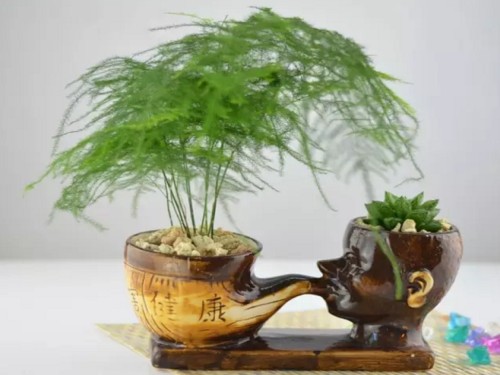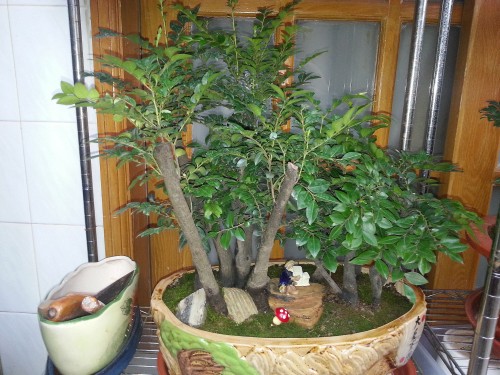How to prune bonsai Phyllostachys pubescens
Asparagus is a perennial vine resident green herbaceous flower, which is called cloud bamboo, pine mountain grass and cloud bamboo mountain grass in some places. Although asparagus has the characteristic of evergreen for many years, if it is not pruned properly in maintenance, it will lead to the symptom of yellowing of branches and leaves and affect the ornamental effect.
Asparagus grows longer and longer after it has been raised for a long time, you know, it is a vine. To maintain the shape of the plant, control watering is a way, less watering in the basin soil, less fertilization, spraying some water on the leaves, spraying some urea and potassium dihydrogen phosphate water. In addition, do not cover the soil too deeply when planting, and expose the Reed head (the joint of root and stem) of asparagus to the soil surface, so that the new buds will not grow too high.
Asparagus with plant-shaped leafy branches dense, high and low scattered is the best. However, after 3 to 4 years of cultivation, the tall vine branches, blooming and fruiting are no longer suitable for indoor viewing and must be pruned. So pruning is very important.

Asparagus should be careful not to cause overgrowth, but the choice of a smaller flowerpot can control the growth of the root system, the height will not be very tall. Proper pruning of dead branches and old vines to promote the germination of new vines. After the new buds grow out, the fast-growing terminal buds can be picked properly to promote the growth of lateral buds. When it grows to a certain extent, branches and leaves can be built properly with scissors.
Asparagus is easy to grow in clusters, first, it should be combined with changing pots to add soil to trim the old and residual whisker roots, dredge the redundant stems and leaves, avoid excessive consumption of nutrients, and play the role of maintaining roots and protecting leaves; the second is to cut off the local yellowing leaves; the third is to cut off the stems and leaves that are yellow at the same time.
Asparagus is full of vitality and grows fast. Don't overprune it in its infancy, but increase its pruning in its prime. We can use scissors or professional pruning work to first trim off the rotten roots and leaves of asparagus, which can reduce the loss of nutrition and better promote the growth of asparagus. Then observe the overall shape of asparagus, trim according to the shape of asparagus you want, cut off the too long part, and pay attention to the principle of moderation when pruning that too much of it will affect the healthy growth of asparagus. The branch that grows too short after the basic setting can also be placed in the sunrise to increase light and photosynthesis and promote its rapid growth. When pruning, it is necessary to ensure the health of asparagus and then consider the beauty of its shape.
1. Missing pruning of leafy branches
When the growth position of the leafy branch on the main branch is not ideal or is missing for some reason, short pruning can be carried out at the appropriate position of the main branch to force the hidden buds to germinate. In general, the height of truncation is the height of leafy branch germination, and the position of prickles on the branch is the location of leafy branch germination, and the thicker the branch is, the higher the germination rate of hidden bud is.
2. Renewal and pruning of the whole plant
If the branches and leaves of the whole plant grow poorly due to strong sunburn or basin soil, lack of fertilizer and for some unknown reason, the whole plant can be renewed. When renewing and pruning, all the leafy branches can be cut off, but we should pay attention to the parts of the branches, because they determine whether the distribution of the remaining branches is uniform. Pruning in the growing season is generally high and easy to sprout new branches, and the amount of water should be reduced appropriately after pruning, never make the basin soil too wet, otherwise it will lead to pruning failure.
3. Pruning of vine branches
Vine branches are generally weak and slender, and if you do not want to leave seeds to make them look good, they can be cut off from the roots at once; if you want to increase the number of leafy branches or fill a vacancy, they can be cut short in certain parts, and special attention should be paid to the comprehensive management of small fat when pruning.
Time: 2019-06-10 Click:
- Prev

How to shape asparagus-the modeling method of asparagus bonsai
Asparagus, also known as Pinus elliottii, Phyllostachys pubescens, Phyllostachys pubescens, is an evergreen foliage plant with high ornamental value. it is a plant of the genus asparagus of Liliaceae. The root of asparagus can be used as medicine and has the effect of treating acute tracheitis and relieving cough. It is mainly used to observe leaves in potted plants, and it is also an important leaf-cutting material.
- Next

Pruning method of lobular red sandalwood bonsai
Red sandalwood is a tropical plant, sunny plant, not resistant to low temperature, well-developed root system and nodules, can fix nitrogen, the soil requirements are not strict. Because the growth is slow, there is no need for special pruning! But yellow leaves, dry tips, withered branches, overgrown flowers affect the beauty, should be often pruned, so as not to affect the beauty. The lobular red sandalwood has strong vitality.
Related
- Fuxing push coffee new agricultural production and marketing class: lack of small-scale processing plants
- Jujube rice field leisure farm deep ploughing Yilan for five years to create a space for organic food and play
- Nongyu Farm-A trial of organic papaya for brave women with advanced technology
- Four points for attention in the prevention and control of diseases and insect pests of edible fungi
- How to add nutrient solution to Edible Fungi
- Is there any good way to control edible fungus mites?
- Open Inoculation Technology of Edible Fungi
- Is there any clever way to use fertilizer for edible fungus in winter?
- What agents are used to kill the pathogens of edible fungi in the mushroom shed?
- Rapid drying of Edible Fungi

